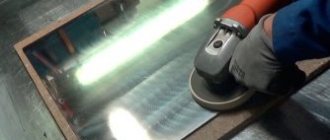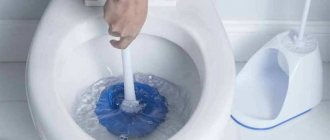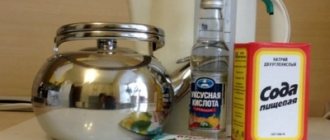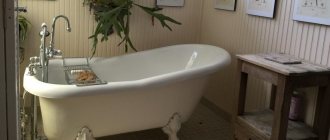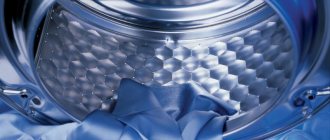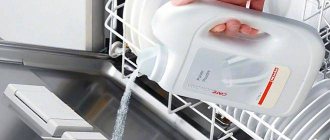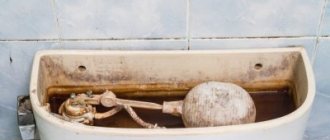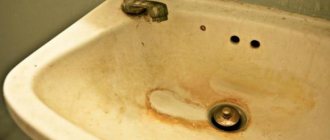Some housewives have stainless steel sinks installed in their kitchens, the popularity of which is growing every day. Kitchen utensils made from this material are in perfect harmony with other appliances and, with proper care, retain their original appearance. They are also considered more aesthetic, hygienic and practical.
But no matter how durable the sink is, stains, plaque and rust can form on it. And therefore, you need to identify the reasons that affect the appearance of the sink and find out with what means and methods you can remove dirt, while avoiding the formation of defects.
How to remove plaque from a stainless steel sink
Many people think that stainless steel kitchen utensils can be cleaned in a matter of minutes if you use chemicals. Of course, household chemicals can save housewives from unnecessary work, but you need to understand that contact with oxidizing particles will cause plaque on the sink.
Therefore, it is better to first try to get rid of contaminants using natural remedies, most of which can be found in every home.
- Lemon acid. Fill the sink with warm water, add a small packet of citric acid and leave for 1.5-2 hours. After the time has passed, wipe the areas with a soft sponge, let the liquid drain out and rinse the sink. You need to be careful with citric acid, as dark spots will appear due to the highly concentrated solution.
- Oxalic acid. Dilute the acid with water, apply the resulting mixture to problem areas and wash off everything after half an hour.
- Dry mustard. Pour the component into the sink, wipe with a sponge, and wash thoroughly. Thanks to mustard, you can get rid of not only plaque, but also unpleasant odors.
- Oven cleaning paste. Apply the substance to the problem area, treat with a sponge, rinse and wipe.
Folk substances are safer because they do not contain harmful particles. They especially help housewives who have small children. Simple remedies will help keep your sink clean and keep your family safe.
Preparation
Before you start cleaning the sink, you should do the following:
- tidy up around all objects that may interfere with the work process;
- wear rubber gloves (highly recommended);
- in case of using chemicals, find a way to ventilate the room;
- clean the sink from large pieces of dirt;
- Do not use metal sponges or brushes to clean the sink;
- do not use strong ammonia or chloride substances - in undiluted form they are dangerous for the coating (but can be used as part of solutions).
Methods for everyday cleaning of your sink
It doesn’t matter what material the kitchen sink is made of, because it always needs to be looked after in order to avoid serious problems in the future. For housewives, this process is automatic; they simply empty the sink of plates and food waste, wipe the surface with a rag soaked in a household product, rinse with water, and then wipe with a kitchen napkin.
However, you need to understand that the procedure should be performed more responsibly. If limescale has just begun to appear on the walls of the sink, on the faucet and on the drain, you need to treat the areas with the hard side of the sponge. Then the surface should be wiped thoroughly so that not a single drop of water remains.
It is because of the hardness of the water that first rainbow spots appear on a stainless steel sink, and then a coating, so these tips should not be neglected.
Recommendations for acrylic bathtubs
Acrylic bathtubs have a perfectly smooth, but prone to damage surface. If handled carelessly, it is easily scratched, and strong concentrated substances can corrode the product. The coating of an acrylic bathtub has no pores, so dirt does not penetrate into it, and cleaning agents are completely washed off with water. But the material is easily painted and can change color: due to rust, acrylic first appears yellow, and then a brown deposit.
Acrylic is not susceptible to corrosion, but it is difficult to wash off old plaque. Entrenched rust can only be removed with aggressive agents that are contraindicated for acrylic surfaces.
The following recommendations will help maintain the integrity of the acrylic coating when cleaning:
- To prevent the detergent from corroding the bathtub, use only special products for acrylic surfaces (there should be information about this on the packaging). For acrylic baths, there are special compositions based on fruit acids.
- Acrylic cannot be cleaned with metal brushes, scrapers or too hard sponges.
- The exposure time of cleaning agents must not be exceeded. Even gentle acidic compounds are best applied for no more than 30 seconds. If it is not possible to remove the plaque immediately, it is better to repeat the treatment after some time rather than overexpose the product and ruin the surface.
- Just in case, it is advisable to test all products on an inconspicuous area.
If you do damage it, here are instructions on how to restore the surface of the bathtub.
Preventative measures
To avoid problems and make the cleaning process easier, you need to remember about prevention.
- Do not use products that contain abrasive particles. Powdery substances will cause small scratches on the sink where dirt and bacteria will accumulate.
- Do not leave food waste on the sink. As soon as you wash the dishes, immediately clean the drain of any remaining food, otherwise new stains will form and eat into the surface.
- Do not use metal brushes. These devices cause defects.
- Polish regularly. The sink should maintain a shiny appearance, so it needs to be treated with vegetable or olive oil 2 times a month.
- Do not leave dirty dishes in the sink for a long time. Because of them, an unpleasant odor, plaque, and rust will appear.
Thanks to the above steps, you can keep your kitchen sink looking flawless and avoid serious problems.
Comet
Comet is a cleaning product that does not contain chlorine or its compounds and is safe for hands. Comet is able to remove any contamination from any surface, of any complexity, even the most neglected. Perfectly cleans the kitchen sink of rust, limescale and other contaminants. This property determined its popularity in the kitchen.
Comet penetrates the surface of the sink and eats away stubborn grease. Comet kitchen cleaner contains chlorinol and an abrasive component. Detergent particles penetrate into the dirt and create foam, which simply removes it. This product should not be used on metal surfaces.
Removing stains
You can remove stains using common substances that are found in almost every home. To get rid of plaque on a stainless steel sink, experienced housewives first of all recommend using hydrogen peroxide, which will not only clean, but also disinfect. In addition, the component is safer than chlorine bleach, which contains ions that are dangerous to stainless steel.
To properly carry out the cleaning process and get rid of contaminants, you must follow the following procedure:
- mix wine vinegar with hydrogen peroxide in a 3:1 ratio;
- moisten the sponge with the solution;
- wipe problem areas;
- leave for 15-20 minutes;
- rinse with water;
- wipe dry.
Scrubbers made of copper are used to remove stuck food and grease. And if you want to get rid of hard plaque, you can use a piece of lemon. To remove stains and rust, the sink is treated with soda solution or oil.
Ceramics: faience and porcelain sanitary ware, ceramic tiles
Waterstone can also form on ceramics. In earthenware or porcelain toilets, near faucets on sinks, around drain holes, on ceramic tiles along the bathtub, and so on - wherever tap water gets in.
How to remove limescale from a ceramic surface? Citric acid is perfect for this.
- Prepare a saturated solution: pour 100 g of citric acid in powder form into 200 ml of warm water, stir thoroughly so that no crystals remain.
- Pour the prepared solution into a spray bottle.
- Spray the resulting solution generously onto the ceramic surface. For greater effectiveness, rub with a sponge as you spray. We don’t save the solution. Then wait 15–20 minutes.
- Wipe again with a wet sponge, then rinse everything off with water and wipe dry.
- If there is plaque left somewhere, place napkins or pieces of cloth soaked in the prepared solution on such difficult areas. Do not touch for half an hour, remove the applied cloth or napkins, clean off the softened plaque with a toothbrush, then rinse everything off with water and wipe dry.
The method is quite effective, safe, cheap and accessible to everyone. Instead of a citric acid solution, the surface can be wetted with 9% food vinegar, apply pieces of cloth soaked in the same vinegar to particularly dirty areas on the ceramic, wait half an hour and wipe with a sponge. Then wash it off. However, vinegar will produce strong fumes; citric acid does not have this problem, and the effect is no worse.
Removing stains from the sink
Even if housewives regularly clean the sink, the procedure does not guarantee a 100 percent result. After all, due to various oxidizing agents, rust will appear on the surface. For proper care, you need to know what products help get rid of certain problems.
4 products to remove dark plaque
Darkened stains may form on the surface of the sink, and in this case the housewife usually uses strong chemicals. But household chemicals can be harmful to health, so it’s better to use improvised means:
- Soda. You need to pour the component onto a hard cloth, wet it with water and wipe the dirty areas. Then rinse and wipe with a soft cloth. To get rid of hard-to-reach stains, just use an old toothbrush.
- Vinegar. If you notice that dark spots have formed on the sink, then you need to moisten a rag with vinegar, wipe the problem areas, wait 25 minutes and rinse.
- Starch. The ingredient helps housewives get rid of rust. You need to close the sink drain, pour in a solution of water and potato starch, wait 40-50 minutes and let in the water.
- Regular bleach. In extreme cases, simple bleach can help remove dark stains. Just rub the problem area with this component and then rinse with water.
Removing heavy soiling
To get rid of grease stains, rust and limescale, you need to stock up on the following equipment: detergent, baking soda, vinegar, salt, sponge/rag, old toothbrush.
So, first you need to close the sink drain, fill the sink with hot water, add detergent (if you don’t want to use household chemicals, you can make a soap solution or buy ready-made liquid soap) and wait until the liquid cools down. When the water is warm, clean the dirty areas of the sink with a toothbrush and baking soda. Next, you need to rub it with vinegar, open the drain and rinse the sink with water.
Vinegar will give your sink a shiny appearance. This component also disinfects the sink and destroys bacteria.
If there are small stains on the sink, they can be treated with a vinegar-salt mixture, left for 25-35 minutes and rinsed.
Getting rid of unpleasant odor
Having cleaned the sink to an impeccable shine, housewives are surprised that a bad smell emanates from it. The cause may be pipes clogged with food debris. But there is a solution to this problem if you use two effective methods.
The first method is used using homemade products - soda and vinegar. You just need to pour 150 g of soda into the drain, pour in the same amount of vinegar, and as soon as the hissing and abundant foam starts, pour boiled water into the hole. This method will 100% help get rid of bad smell and blockage.
The second method is using the “Mole” cleaning product. Following the instructions, you need to pour the required amount of the component into the drain, fill everything with water, and then rinse.
Options for cleaning tile joints
Joint fillers, as a rule, have high porosity, and therefore splashes of soapy water and settling dust eat into them very strongly.
Various types of bleaches and stain removers for clothes come to the rescue. Cleaning with their help is a rather painstaking process. Each seam should be thoroughly cleaned with an old toothbrush, but the remaining cleaning agent should not be washed off immediately.
Seams can also be cleaned well with all kinds of chlorine-containing compounds. If the dirt has become very ingrained, the original appearance can only be restored by removing the old filler and using new grout. In this case, it is recommended to either select the grout to match and then paint it with waterproof paint, or cover the seam of the desired color with a special hydrophobic pencil. The work is quite painstaking, but the result is definitely worth it.
The appearance of unpleasant stains on clothes and household items can ruin your mood for a long time and deprive you of peace of mind. Rust can occur anywhere and be imprinted on all objects that have been in contact with the place where it originated. In order not to get confused in such a situation, learn the most effective methods of dealing with stains.
Types of sinks by installation method
In the kitchen you can find different types of sinks. They are usually divided according to the method of equipment and there are three varieties that have certain characteristics.
- Overhead sinks are “slipped” onto a floor cabinet. This type serves not only as a sink, but also as a countertop. Housewives do not have to worry about sizes, since manufacturers make small, medium and large sinks. To install a sink, you don’t have to call a professional, because the overhead type is very easy to install with your own hands. But it is worth noting that this type has one drawback - subtlety. Because of this negative point, the countertop sink may be subject to various defects and will last less than other types.
- The built-in sink is easily installed on the countertop. This type is becoming more popular every day. When installing the sink, no seams or cracks will form, which automatically prevents liquid accumulation.
- The integrated sink has a different structure of sides, i.e. 2 or 3 sinks are connected into a common façade. But this type is difficult to install yourself, so it is better to call a specialist. It will also require a special mixer that can easily make various turns. This type of sink should be installed just below the level of the countertop.
Keeping clean is easy
So that you don’t have to ask search engines “how to clean the sink” and devote a lot of effort to cleaning it, you just need to keep it clean every day. Here are two simple daily actions that will help you avoid heavy soiling in your kitchen:
- After using the washbasin, at night, wash off food residues from it, if it is a kitchen, grease, soap traces and other contaminants with warm water, if necessary, use a regular detergent;
- Wipe dry with a soft towel or cloth.
These simple, regular actions can help you avoid heavy contamination and save your energy for more important and interesting things than cleaning the sink.
Types of pollution
Before you start cleaning sinks, you need to understand the nature of the problem, since there are different types of dirt, so they need to be cleaned using different methods.
How to remove limescale
The composition of the water contains a large amount of magnesium and calcium salts, due to which lime settles on the sink. To get rid of plaque, while maintaining the material in its original form, you need to use methods that are divided into two groups.
Chemicals. In household chemical stores you can find cleaning products that can quickly and efficiently deal with limescale. The most popular of them: BAGI acrylan, Comet gel, Cillit Bang.
But before you buy this or that product, you need to read the instructions in order to avoid problems in a timely manner.
Folk remedies. If you do not want to use household chemicals, then a stainless steel sink can be cleaned using available products. The most popular of them:
- salt;
- ammonia;
- hydrogen peroxide;
- lemon acid.
If you want to clean the sink from whitish spots and give it an impeccable shine, then moisten the sponge with 9% table vinegar, treat the problem areas and rinse the sink after 25 minutes.
How to remove rust
Rust is a little more difficult to clean, so for best results you can use one of the following methods.
- Hydrogen chloride. The substance helps get rid of old rust. You just need to wet a rag, apply it to the problem area for 15 minutes, and then rinse with water.
- Baking soda. The component helps get rid of a thin layer of rust. Sprinkle baking soda on the stains, after 2 minutes spray with table vinegar, and as soon as the hissing stops, go over with a cloth and rinse.
- Ammonia and hydrogen peroxide. By making a solution of these two components (proportions 2:1), you can give your plumbing fixtures a shiny look. The contaminated areas are treated with the prepared mixture and washed off with water after 15-20 minutes.
How to clear yellowness
As soon as you see a yellow coating on the plumbing, remove it immediately, otherwise rust will form. You can get rid of this problem using citric acid. Pour the substance onto problem areas, wait 5-10 minutes, treat with table vinegar, wipe with a rag and rinse. If you can’t immediately achieve a positive result, you can try again.
Interesting! The vinegar method helps get rid of not only yellow stains, but also stuck food debris.
How to remove dark spots
Dark spots look unpleasant and can be harmful to health, so you need to get rid of them in a timely manner. For an effective result, mix 100 ml of ammonia and the same amount of water, treat the dark areas with the resulting mixture, after 6-7 hours, go over with a cloth and wash the sink with a cleaning agent.
Important! Regardless of the types of contamination and cleaning methods, every housewife should take care of her health. Therefore, before cleaning the sink, you need to put on special gloves on your hands and a mask on your face. They will help keep your hands free from allergies and avoid poisoning.
All of the above methods help to quickly and efficiently clean a stainless steel sink without much effort or wasting time.
Household chemicals
The use of special products allows you to quickly clean a stainless steel sink in the kitchen, polish it and restore the protective layer.
- HG polish for stainless steel - recommended for the care of sinks, dishes and household appliances. Pros: leaves no streaks, removes dirt and grease, eliminates tarnish. Cons: high price. The creamy composition is applied to a damp cloth, then the contaminated area is wiped. Wash off with water and wipe the surface with a dry cloth.
- Steel Polish Grass is a liquid designed for surfaces that require delicate care. Perfectly restores the shine of stainless steel. Pros: erases dirt, fingerprints, shine, low cost. Minus: does not cope well with limescale. Shake the bottle before use and spray the product onto the sink. For polishing, use a soft, lint-free cloth.
- Dr. Beckmann - foam for cleaning metal surfaces removes traces of oxidation, grease, soap and limescale deposits. Pros: effectiveness, pleasant smell, safe polishing. Cons: small volume. Apply the foam to the damp surface of the sink, rinse with a sponge after 2-5 minutes.
Home remedies for cleaning stainless steel cutlery
Using home remedies, you can clean not only the sink, but also tableware.
- The easiest way to clean stainless steel items is dish gel. The component is squeezed onto a sponge, the devices are thoroughly wiped, then rinsed under water and wiped with a dry cloth to prevent white streaks from appearing.
- A simple way is boiling. You need to put the equipment in a large container, fill it with boiled water and put it on medium flame. After boiling for 25-55 minutes, the devices should be washed in warm water and wiped.
- Toothpaste. Apply the component to a sponge, process the products, rinse in warm water and wipe.
- A solution of water and mustard. Mix mustard powder in warm water to form a paste, wipe the devices and wash them.
- Brewing residue can be removed with vinegar. Pour some vinegar into a rag, wipe the items and rinse them. If you want to get rid of stubborn stains, place kitchen items in a large container, pour in a little vinegar and water, leave for 25-30 minutes, and then wash.
- In extreme cases, ash can be used to clean appliances. The component is moistened in warm water, applied to a sponge, wiped the kitchen utensils, then placed the items in a container with warm water, left for 5-10 minutes, cleaned with a regular product and wiped dry.
Important! Stainless steel products cleaned using home remedies should be stored in kitchen compartments, away from dust, water and other sources of contamination.
Every housewife likes to look at a shiny sink, and therefore you need to listen to advice and properly care for it. By daily cleaning to remove food debris and moisture, you can achieve an attractive glow and impeccable cleanliness.
General rules
Rust occurs from the interaction of oxygen with untreated metal. It also often appears in places with high humidity or when metal interacts with water. Often the surface of the metal is coated with various compounds to provide protection from external influences, but if rust does appear, there are several ways to remove it.
There are several rules and tips that will help you remove rust stains from various surfaces at home:
- Removing rust from any surface involves the use of acids. Therefore, you should always have rubber gloves and wear them when working with chemicals;
- When cleaning, remove children and pets from the premises. After work, ventilate the room;
- Be sure to wash other contaminants from the surface before removing rust;
- Before cleaning rust, rinse the area with water and wipe dry.
